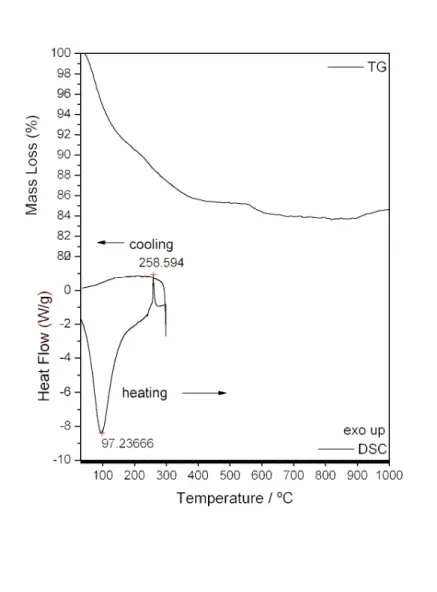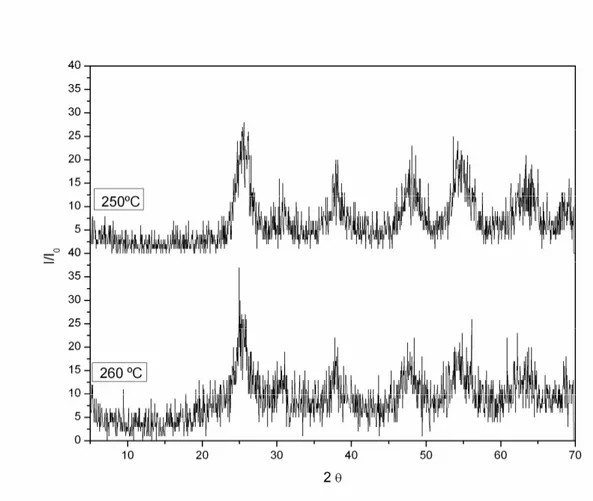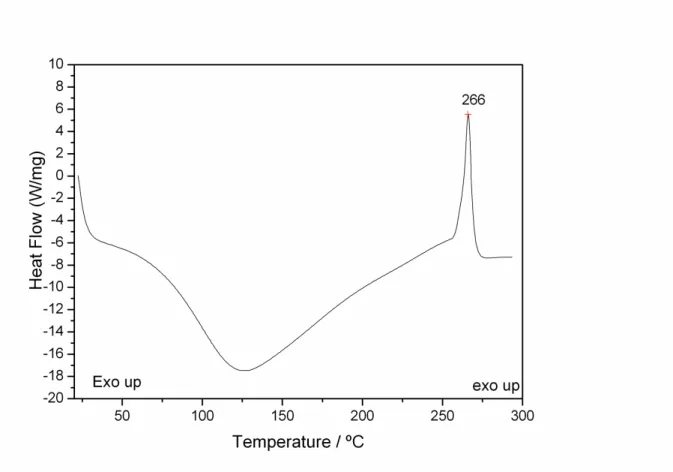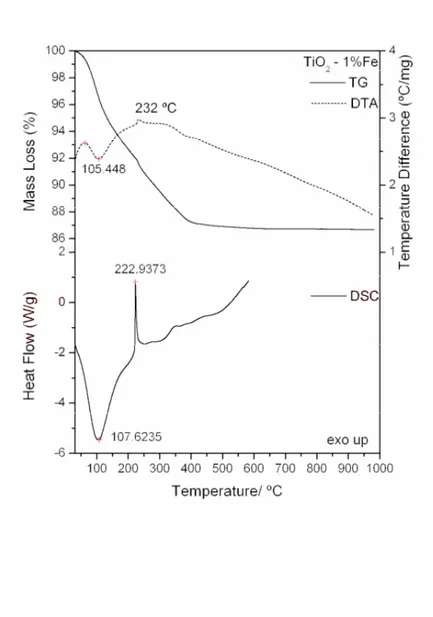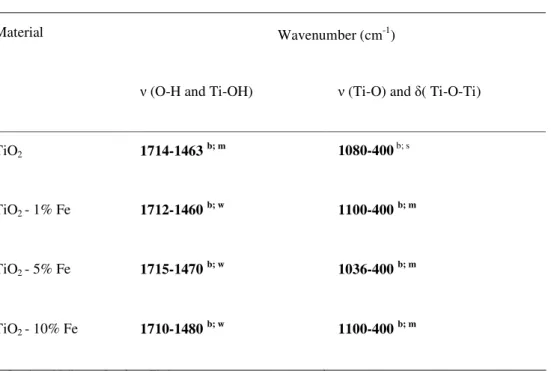Synthesis and characterization of Fe(III)-doped ceramic membranes of titanium
dioxide and its application in photoelectrocatalysis of a textile dye
Emanuel C. Rodrigues a1, Layciane. A. Soares a, Marco A. Modenes Jr a, Jeosadaque J. Sene a,
Gilbert Bannach b, Claudio T. Carvalho c and Massao Ionashiro c.
a* Centro Universitário da Fundação Educacional de Barretos, UNIFEB, CEP 14780-226,
Barretos, SP, Brazil; emanuelbarretos@bol.com.br.
b Instituto de Química, UNESP, CEP 17033-360, Bauru, SP, Brazil.
c Instituto de Química, UNESP, C.P. 355, CEP 14801-970, Araraquara, SP, Brazil.
Abstract
______________________________________________________________________________
Pure and Fe(III)-doped TiO2 suspensions were prepared by the sol gel method with the use of titanium isopropoxide (Ti(OPri)4) as precursor material. The properties of doped materials were compared to TiO2 properties based on the characterization by thermal analysis (TG-DTA and DSC), X-ray powder diffractometry and spectroscopy measurements (FTIR). Both undoped and doped TiO2 suspensions were used to coat metallic substrate as a mean to make thin-film electrodes. Thermal treatment of the precursors at 400°C for 2 h in air resulted in the formation of nanocrystalline anatase TiO2. The thin-film electrodes were tested with respect to their photocatalytic performance for degradation of a textile dye in aqueous solution. The plain TiO2 remains as the best catalyst at the conditions used in this report.
Keywords: TiO2; Fe(III) doping; characterization; thin film electrode; textile dye.
WWW.SCIELO.BR/EQ
Introduction
Titanium dioxide (TiO2) is a polymorphous crystalline solid which exists in a tetragonal phase as anatase and rutile, as well as, in a rhombic phase called brookite. The most common forms, anatase and rutile, are easily prepared as ceramic membranes by several methods of synthesis [1].
Accordingly, the sol-gel method allow to the preparation of ceramic materials such as powders, fibers and membranes at relatively low temperature when compared to conventional methods. Also, metal-doped materials can be prepared in such a way that the stoichiometry, particle size and porosity are controllable. Such materials have been characterized by a number of different techniques as thermal analysis (thermogravimetry (TG), differential thermal analysis (DTA), and differential scanning calorimetry (DSC)), X-ray diffraction, scanning electronic microscopy, and spectroscopy techniques [2-14].
TiO2 ceramic membranes have been widely used as a photocatalyst to degrade pollutants in aqueous phase, as well as, in the gaseous one. For that purpose, the semiconductor must be activated by light of energy greater than the band gap energy of the material which can be accomplished by the use of artificial ligth or better yet by solar energy. The activation gives rise to the formation of electrons in the conduction band and positive holes in the valence band, these being responsible for the oxidation of organic matter [15].
Some reviews on the use of titanium dioxide (TiO2) as a photocatalyst are available in the literature, which present the current progress in the field as well as a discussion of the fundamental aspects [16-18].
Iron (III) ions have been demonstrated to improve the catalytic activity of TiO2 toward the oxidation of organic pollutants. These results are encouraging since the properties of TiO2 photocatalysts are suitable for the construction of photochemical energy conversion systems and the treatments of pollutants and wastewater [22-27]. Several studies have claimed that TiO2 as anatase coexists with metallic iron at acidic pH or in situations where the doping level of iron is less than 1% (m/m) which enhance the photocatalytic properties of TiO2. As the doping level goes higher or at higher pH, the phase -Fe2O3 has much more probability to form which cause the transformation of TiO2 from anatase to rutile [28-31].
In this paper studies on the preparation of Fe(III)-doped TiO2 are described. Materials with the percentage of metal doping of 1%, 5% and 10% were synthesized and their properties compared to those of plain TiO2 based on the characterization by thermal analysis and spectroscopy measurements. In addition, thin-film electrodes made out these materials were used to photoelectrocatalitically degrade a textile dye in aqueous solution.
2. Experimental
2.1 Materials
Titanium sol was prepared by adding titanium isopropoxide, Ti(OPri)4 (Aldrich, Milwaukee, WI), to an aqueous solution of nitric acid at a volumetric mixing ratio of 2.1 mL concentrated HNO3/238 mL H2O/20 mL Ti(OPri)4. The sol was stirred continuously until peptization was complete, after which the sol (pH 1.0) was dialyzed (Spectra/Por1 3 membrane, 3500 MW cutoff, Spectrum, Laguna Hills, CA) to a final pH 3.5. The iron-doped sols were prepared by a similar procedure with the addition at the initial step of the required amount of iron (III) nitrate to obtain 1, 5 and 10% atom ratio of iron to titanium.
2.2 Methods
mg for DSC. Alumina and aluminum crucibles, the latter with perforated covers, were used for TG-DTA and DSC, respectively.
Infrared spectra were recorded on a Nicolet mod. Impact 400 FT-IR instrument, within the 4000–400 cm–1 range. The solid state samples were pressed into KBr pellets.
X-ray powder patterns were obtained by using a Siemens D-5000 X-Ray Diffractometer, employing CuKα radiation (λ=1.541 Å) and settings of 40 kV and
20 mA.
UV/Vis spectra were recorded on a HACH DR/4000 U spectrophotometer within the 190 - 1100 nm range.
3. Results and discussion
3.1 Thermal analysis
Simultaneous TG-DTA and DSC curves of the compounds exhibit mass losses in steps and thermal events corresponding to these losses or due to physical phenomenon. The TG-DTA curves also show that the anhydrous compounds are formed up to 650 ºC. The presence of iron as doping in the gel sample caused the lowering of the degradation temperature. The temperature ranges ( ), mass losses (%) and peak temperatures observed for each compound are shown in Table1.
Table 1. Temperature ranges ( ), mass losses (%) and peak temperatures observed for each compound.
Compound
TG-DTA
Steps
DSC
Steps
First Second First Second
TiO2* ºC 30- 650 -
Peak (ºC) 97 (endo) 259 (exo; sharp)
TiO2- 1% Fe ºC 38-185 185-457
Loss (%) 13.00
Peak (ºC) 105 (endo) 232 (exo; small) 108 (endo) 223 (exo; sharp)
TiO2 - 5% Fe ºC 30-200 200-451
Loss (%) 14.73
Peak (ºC) 100 (endo) 195-370 (exo; broad)
99 (endo) 201 (exo; sharp)
TiO2 - 10% Fe ºC 30-207 207-523
Loss (%) 12.50
Peak (ºC) 99 (endo) 207-352 (exo; broad)
101 (endo) 224 (exo; sharp)
* This compound was obtained in Mettler equipment.
3.2 Undoped TiO2
in the X-ray spectra shown in Fig. 2, there are no differences in the patterns of diffraction after to heat the sample up to the temperature of 250ºC and 260ºC, showing that the crystalline phase is the same in both cases. In the DSC curve, the exothermic peak observed at 259ºC in air atmosphere, also occurred in a N2 atmosphere at 266 oC. The appearance of this exothermic peak in N2 atmosphere (Fig. 3) is in disagreement with reference [34].
Figure 1. TG and DSC curves of undoped-TiO2.
Figure 2. X-ray diffraction spectra of TiO2 heated up to: (a) 250 oC; (b) 260 oC.
Figure 3.DSC curve of TiO2 under N2 atmosphere 3.3 Fe (III)-doped TiO2
The TG-DTA and DSC curves of the titanium dioxide doped with iron (1, 5 and 10%) are shown in Figs. 4, 5 and 6. A great similarity is observed between the TG-DTA and DSC curves of the TiO2 doped and the profile of these curves also show a great similarity with the TG-DTA and DSC curves of the titanium dioxide without doping.
However the exothermic peak attributed to the thermal decomposition of the organic matter and sintering occurs in different temperature depending on the quantity of the iron as doping (Table 1).
Figure 4. TG-DTA and DSC curves of 1% (w/w) Fe (III)-TiO2
Figure 6. TG-DTA and DSC curves of 10% (w/w) Fe (III)-TiO2
Figure 6.TG-DTA and DSC curves of 10% (w/w) Fe (III)-TiO2
3.4 Fourier-Transformed Infrared Spectroscopy (FTIR)
attributed to O-H and Ti-OH groups. However, these two bands diminish their intensity in the iron (III) doped-TiO2 suggesting that have occurred change in the structure of the materials.
Table 2. Infrared spectroscopic data regarding doped and undoped-TiO2 ceramic membranes heated up to 400 oC.
Material Wavenumber (cm-1)
(O-H and Ti-OH) (Ti-O) and ( Ti-O-Ti)
TiO2 1714-1463 b; m 1080-400b; s
TiO2 - 1% Fe 1712-1460 b; w 1100-400 b; m
TiO2 - 5% Fe 1715-1470 b; w 1036-400 b; m
TiO2 - 10% Fe 1710-1480 b; w 1100-400 b; m
b – Broad; m – Medium; s – Strong; w – Weak
3.5 X-ray diffractometry
3.6 Photoelectrocatalytic degradation of a textile dye
Thin-film electrodes made out of the iron (III) doped and undoped TiO2 materials were used to investigate the degradation of a textile dye by photoelectrocatalyse experiment. The electrodes were made with a three layers deposition of each material on a metallic substrate of titanium with a thickness of 0.5 mm (Goodfellow Cambridge Ltd.) and heated at 400 ºC for two hours. These electrodes were used as anode with a biased potential of 1.5 V (vs Ag/AgCl) and illuminated by a UV irradiation. A platinum wire was used as auxiliary electrode. The experiments were carried out for two hours in solutions of 0.05 g L-1 of the dye Acid Blue 29 [5850-35-1; Aldrich] and 0.1 mol L-1 NaCl as electrolyte. The variation in the dye concentration during the experiment was monitored by UV-Vis measurements.
Figure 8. Variation in absorbance as a function of time during the photoelectrocatalytic degradation
of the Acid Blue 29 dye using the undoped-TiO2 thin film electrodes.
4. Conclusions
X-ray diffraction allowed to observe that through heating the anatase form of TiO2 is prevalent at the temperature studied. The doping metal has the effect of diminish the height of peaks due to TiO2. The infrared spectra showed the presence of absorption due to Ti-O bonding. Also in the presence of the doping metal this absorption is diminished.
As a result of the photoelectrocatalitic degradation of a textile dye, plain TiO2 remains as the best catalyst at the conditions used in this report. Among those doped catalyst, the 5% Fe (III) was able to degrade more dye than the others in the two hours of experiment.
Acknowledgements
The authors thank FAPESP, CNPQ and CAPES Foundations (Brazil) for financial support; Electroanalytical and Environmental Chemistry Group and Thermal Analysis Laboratory Ivo Giolito.
References
[1] A. C. F. M. Costa, M. A. Vilar, H. L. Lira, R. H. G. A. Kiminami, L. Gama, Cerâmica 52 (2006) 255.
[2] R. F. Silva, W. L. Vasconcelos. Mat. Res 5 (2002) 497.
[3] J. J. Sene, N. R. Stradiotto, W. A. Zeltner, M. A. Anderson, W. Zhou, Sens. Actuators, B 87 (2002) 268.
[4] Q. Xu, M. A. Anderson, J. Am. Ceram. Soc. 77 (1994) 1939. [5] Q. Xu, M. A. Anderson, J. Mater. Res. 6 (1991) 1073.
[6] I. Truijen, M. K. Van Bael, H. Van Den Rul, J. D’haen, J. Mullens, J. Sol-Gel Sci. Technol. 41 (2007) 43.
[7] Y. Li, S. H. Lim, T. White, Int. J. Nanosci. 3 (2004) 749.
[8] M. M. Viana, T. D. S. Mohallem, G. L. T. Nascimento, N. D. S. Mohallem, Braz. J. Phys. 39 (2006) 1081.
[11] H. Yang, R. Shi, K. Zhang, Y. Hu, H. Zhang, Int. J. Nanosci. 5 (2006) 239. [12] H. Xie, T. Xi, Q. Zhang, Q. Wu, J. Mater. Sci. Technol. 19 (2003) 463. [13] R. A. Zoppo, N. H. R., Mortean, Quim. Nova 23 (2000) 729.
[14] M. Crisan, A. Brãileanu, D. Crisan, M. Rãileanu, N. Drãgan, D. Mardare, V. Teodorescu, A. Ianculescu, R. Birjega, M. Dumitru, J. Therm. Anal. Cal. 92 (2008) 7.
[15] R. F. P. Nogueira, W. F. Jardim, Quim. Nova 21 (1998) 319.
[16] A. Fujishima, T. N. Rao, D. A. Tryk, J. Photochem. Photobiol. 1 (2000) 1. [17] A. Wold, Chem. Mater. 5 (1993) 280.
[18] S. Qourzal, A. Assabbane, Y. Ait-Ichou, J. Photochem. Photobiol., A 63 (2004) 317. [19] K. V. S. Rao, B. Lave´drine, P. Boule, J. Photochem. Photobiol., A 154 (2003) 189. [20] R. L. Ziolli, W. F. Jardim, Quim. Nova 21 (1998) 319.
[21] J. W. J. Hamilton, J. A. Byrne, C. Mccullagh, P. S. M. Dunlop, Int. J. Photoenergy. 2008 (2008) 1.
[22] M. Macek, B. Orel, T. Meden, J. Sol-Gel Sci. Technol. 8 (1997), 771.
[23] T. Ohno, D. Haga, K. Fujihara, K. Kaizaki, M. Matsumura, J. Phys. Chem. B 101 (1997) 6415.
[24] G. Balasubramanian, D. D. Dionysiou, M. T. Suidan, I. Baudin, J. Laîné, J. Mater. Sci. 38 (2003) 823.
[25] G. Balasubramanian, D. D. Dionysiou, M. T. Suidan, I. Baudin, J. Laîné, Appl. Catal., B 47 (2004) 73.
[26] V. Balek, N. Todorova, C. Trapalis, V. Stengl, E. Vecernikova, J. Subrt, Z. Malek, G. Kordas, J. Therm. Anal. Cal. 80 (2005) 503.
[27] M. Asilturka, F. Sayilkana, E. Arpac, J. Photochem. Photobiol., A 203 (2009) 64. [28] Y. Wang, F. Cheng, Y. Hao, J. MA, W. Li, S. Cai, J. Mater. Sci. 34 (1999) 3721. [29] X. Li, P. Yue, C. Kutal, New J. Chem. 27 (2003) 1264.
[32] E. Piera, M. I. Tjedor, M. E. Zorn, M. A. Anderson, Appl. Catal., B 46 (2003) 671. [33] K. P. Biju, M. K. Jain, Sens. Actuators, B 128 (2008) 407.
[34] D. Beydoun, R. Amal, Mater. Sci. Eng. 94 (2002) 71.
[35] N. S. Mcintyre, K. R. Thompson, W. J. Weltner, J. Phys. Chem. 75 (1971) 3243. [36] Y. Tanaka, M. Suganuma, J. Sol-Gel Sci. Technol. 22 (2001) 83.
[37] T. Ivanova, A. Harizanova, Solid State Ionics 138 (2001) 227.
[38] J. W. Shi, J. T. Zheng, Y. Hu, Y. C. Zhao, Mater. Chem. Phys. 106 (2007) 247. [39] B. Tryba, Int. J. Photoenergy. 2008 (2008) 1.
E. C. Rodrigues, L. A. Soares, M. A. Modenes, J. J. Sene, G. Bannach, C. T. Carvalho e M. Ionashiro. Síntese e caracterização de membranas cerâmicas de dióxido de titânio dopadas com Fe(III) e sua aplicação em fotoeletrocatálise de corante têxtil.
Resumo:
Foram preparadas suspensões de TiO2 dopadas com Fe(III) pelo método sol-gel. As propriedades dos materiais dopados foram comparadas com a de TiO2 puro, baseadas na caracterização por análise térmica (TG-DTA e DSC), difratometria de raios X e medidas espectroscópicas (FTIR). As suspensões de TiO2 puras e dopadas foram depositadas sobre substrato metálico, obtendo-se assim eletrodos de filme fino. O tratamento térmico destes precursors a 400 oC por um período de 2 horas resultou na formação de fase cristalina anatase. Os eletrodos foram utilizados em processo fotoeletrocatalítico para a degradação de corante têxtil em solução aquosa. Verificou-se que o eletrodo de TiO2 puro apresentou melhor desempenho no processo de degradação do corante.

